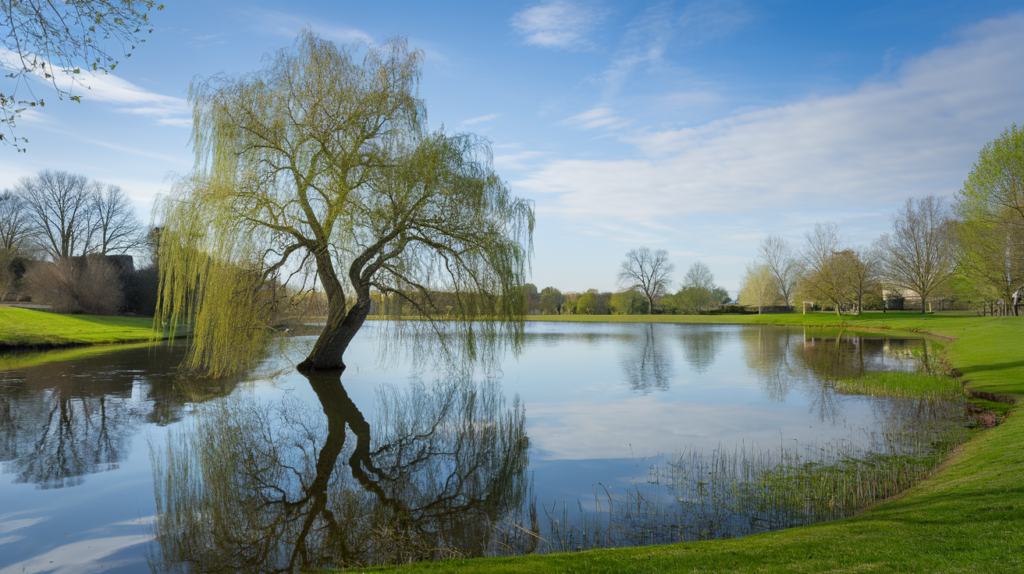Weeping willow trees are known for their graceful, flowing branches and tranquil beauty. These trees create a stunning landscape that captivates nature lovers and photographers alike. In Connecticut (CT), weeping willows are especially striking as they blend with the state’s picturesque environment, offering some of the most beautiful views you can capture.
In this article, we will explore the charm and significance of weeping willow trees, highlighting why they are such an important part of Connecticut’s landscape. We will also dive into tips on how to capture stunning photos of these trees and explore some of the best locations in Connecticut to find them.
The Beauty of Weeping Willow Trees
Weeping willows (Salix babylonica) have a unique and recognizable appearance. Their long, drooping branches seem to weep toward the ground, creating an elegant, curtain-like effect. The leaves of weeping willows are slender and fine, giving the tree an airy, flowing presence.
Their distinctive shape allows them to stand out in any environment, whether they are by a pond, riverbank, or meadow. In Connecticut, weeping willows thrive near water sources, where their roots can access moisture, making them a common sight along lakes, streams, and marshes.
Why Weeping Willow Trees are Popular in CT
Connecticut’s climate and diverse landscapes provide an ideal setting for weeping willows. With its seasonal changes and varying natural environments, the state offers a range of beautiful backdrops that complement these trees. During the spring and summer months, the bright green leaves of the willows contrast beautifully against the blue sky and vibrant greenery.
In fall, the willows take on golden hues, adding to the visual drama of the autumn foliage. Even in winter, when the leaves have fallen, their bare branches create hauntingly beautiful silhouettes against the snow-covered ground.
Weeping willows are often planted in public parks, private gardens, and near water features due to their calming presence. Many people are drawn to their serene appearance, which evokes feelings of peace and tranquility.
Capturing Stunning Photos of Weeping Willow Trees
To capture stunning photos of weeping willow trees in Connecticut, consider these key tips:
Focus on Composition
The drooping branches of the weeping willow create natural lines that can guide the viewer’s eye throughout the photo. Utilize this feature to create strong compositions. For example, position the tree off-center to follow the rule of thirds, allowing the surrounding landscape to balance the image.
Use Water Reflections
Weeping willows are often found near water, which provides excellent opportunities for reflection shots. Capture the tree’s reflection in still water, such as a lake or pond, to create a mirror-like effect. This doubles the visual impact of the scene, making the tree appear even more dramatic.
Experiment with Lighting
The golden hour, which occurs just after sunrise and before sunset, provides soft, warm lighting that enhances the natural beauty of the weeping willow. The soft light will highlight the texture of the branches and leaves, creating a dreamy, ethereal atmosphere. Backlighting can also work well, as it allows the light to filter through the leaves, creating a glowing effect.
Capture Seasonal Changes
One of the best ways to photograph weeping willows is to showcase their beauty across different seasons. In spring, focus on the fresh green leaves and blossoming flowers around the tree. During autumn, the golden leaves and vibrant colors make the scene even more breathtaking. Winter can provide minimalist compositions, with the bare branches creating stark, elegant lines.
Play with Perspective
Don’t hesitate to get creative with your angles and perspectives. Shooting from a low angle can make the weeping willow appear even more towering and majestic. Alternatively, try framing the tree with other natural elements, like nearby plants or flowers, to add depth to your shot.
Best Locations to Find Weeping Willow Trees in CT
Connecticut is home to several picturesque locations where you can find and photograph weeping willow trees. These are some of the top spots:
Elizabeth Park, Hartford
Elizabeth Park is famous for its rose gardens, but it also offers beautiful views of weeping willows. The trees here are located near ponds and provide a stunning backdrop for nature photography.
Wadsworth Falls State Park, Middletown
This state park features waterfalls, rivers, and ponds, where you can find weeping willows growing near the water. The park’s natural beauty combined with the presence of these trees creates ideal conditions for capturing breathtaking landscape photos.
Hubbard Park, Meriden
Hubbard Park is known for its scenic walking trails, lakes, and diverse plant life. The weeping willows here are a favorite subject for photographers looking to capture the beauty of Connecticut’s nature.
Bushnell Park, Hartford
As one of the oldest public parks in the United States, Bushnell Park features weeping willows alongside its iconic carousel and memorials. The combination of natural beauty and historical landmarks provides a unique setting for photography.
Lake Waramaug, New Preston
Lake Waramaug offers some of the most stunning views of weeping willows in Connecticut. The calm waters of the lake perfectly reflect the elegant branches of the trees, creating a serene and picturesque scene.
Importance of Weeping Willows in Connecticut’s Ecosystem
In addition to their aesthetic appeal, weeping willows play an important role in Connecticut’s ecosystem. They provide shade and shelter for wildlife, especially near water sources. Their extensive root systems help prevent soil erosion along riverbanks and shorelines. These trees also absorb excess water, making them beneficial for flood-prone areas.
Weeping willows are commonly used in restoration projects to stabilize soil and improve water quality. Their fast growth rate and ability to thrive in wet environments make them a practical choice for planting in areas that require erosion control.
Conclusion
Weeping willow trees are a beloved feature of Connecticut’s landscape, offering stunning views and a peaceful atmosphere. Their flowing branches and graceful shape make them a popular subject for nature photography. By following the tips outlined above, you can capture the beauty of these trees in all their seasonal glory.
Whether you visit parks, lakes, or rivers in Connecticut, you’re sure to find weeping willows that inspire awe and admiration. Not only do they enhance the visual appeal of the state’s natural environment, but they also contribute to the local ecosystem by preventing erosion and providing wildlife habitat.
The next time you explore Connecticut, take a moment to appreciate the serene beauty of the weeping willow trees and consider capturing them in your own stunning photos.



